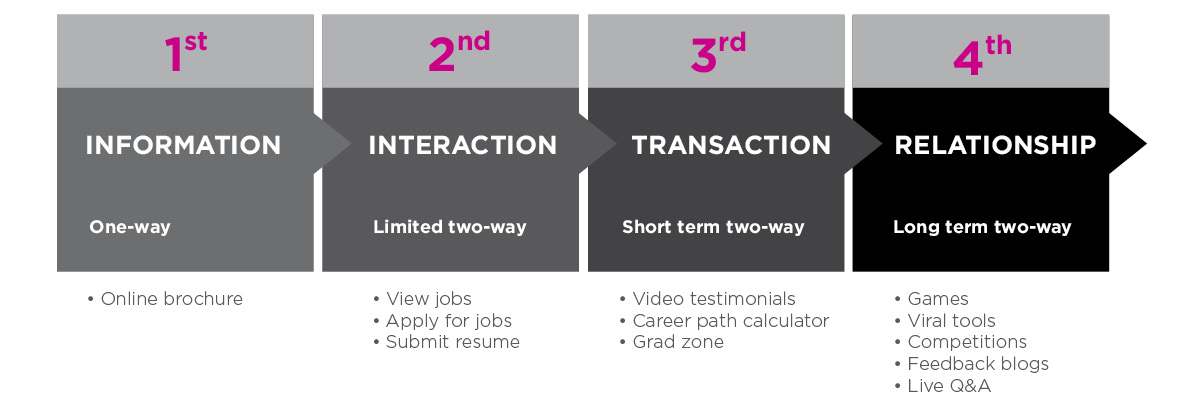
Insider tips to extraordinary careers websites
The three main sources of traffic on any corporate website are customers, shareholders and potential (and often existing) employees. It’s a sad fact that most of the site’s focus is on the first two groups, with the third group often getting minimal attention. If we consider that an organisation’s website is a critical research tool for potential candidates in selecting an employer (A recent study found that 59% of job seekers go directly to the company website to research potential employers) this seems to be a major oversight.
The truth is that the impossibly rapid pace of development in the online environment has conditioned people into expecting more and more from websites. As the Employer Marketing industry matures and potential candidates are faced with increasingly sophisticated communications, the need to respond to the competition and adjust your opinion of what is ‘good enough’ grows.
There is a wide variety of opinion around what makes a great website, and how they should look and function, but the beauty and attraction of websites is so highly subjective. So instead we will aim to give some practical advice simply around the features a site should include, its function, and how it fits into your sourcing strategy.
TIP #1 – Have a dedicated careers site
A dedicated careers website is a self-contained site which focuses on the offer to potential talent. It can be designed within corporate guidelines to mirror the look and feel of the organisation’s main website, but has a stand-alone URL, and can be hosted and maintained separately by HR.
Sure, you will list your current vacancies, but this is not the main function for the site – not everyone looking will be active job seekers. The role of your careers site is for talent to learn more about your employment offering and lead them to question whether they are happy with the job they currently have.

TIP #2 – A boring website is NOT better than no website
Your audience will see you as dull if you have a dull site. Your careers website should be a dynamic, virtual representation of your company. It acts as a 24/7 shop window of your organisation in which people can enter and leave (sometimes forever) at will, and you’ll never know. It must be a living breathing representation of what you would like your company to be. It must be as compelling as your best salesperson and as credible as your CEO. It might be the first and last time someone you want to meet gets close to you.
Websites have come a long way since the first clunky, and frankly boring, sites that appeared in the early 90s. Over the last 20 or more years, (most) sites have gone through several generic evolutions of purpose, as shown by this diagram:

But some site owners seem to think that a static online brochure with a few stock shots of people standing around a computer/wearing hard hats/hi-vis jackets/doing high fives/smiling into a phone/generally looking unrealistically happy with reams and reams of text-based testimonials from employees are going to impress people. That’s highly unlikely…
TIP #3 – Create an experience
Are you getting lots of visitors to your site but getting low engagement and direct applications?
It might be time to assess the quality of your site.
How? Why not step into the shoes of your talent or ask your existing employees? They are after all possibly your most important audience, as employees often look at their own organisation’s website to figure out if they’re in the right company. Also ask the newest hires coming in whether the website helped or hindered their decision to apply?
Companies around the world are now beginning to realise the awesome power and at times awful consequences of the Talent Experience. And a crucial component of this experience is the time they spend on your company website.
Want to learn more about creating a candidate experience that trumps your competitors?
These days websites are more closely related to TV shows than printed brochures, and using modern technology and software is not a luxury. But a good experience is about more than just the graphics, it’s about providing useful content that is relevant to your target audience. Include a career-path chart for graduates to see how their career with you over the next 5 years might develop. Include information about the facilities near your offices, transport guides of how to get there (so they can see how easy the commute is compared to their current employer) and details of local child-care centers.
Not only will you impress your target audience with the thoroughness of your research and willingness to think of their welfare, but you’ll save your recruitment team from having to answer all these questions manually.

TIP #4 – Tell them what’s in it for them!
You may be wondering why this tip is the last one on the list. Well, if you only remember one tip, we hope it is the last one you read.
While giving people information about the closest transport, schools and coffee is great, it will not be the driving force for them to change employers. There has to be something more in it for them.
Your employees can contribute more than just feedback on website experience. They play the lead role in showcasing your culture both inside and outside your organisation – so get them involved.
Your employees can help you define your unique employment offering (EVP and messaging pillars) and of course are the perfect people to tell everyone about it! Make some unscripted videos of employees talking about your organisation, or get them to show visitors around, just like they were really in the building.
Getting leadership support for this should not be too difficult – it is after all the doorway into your organisation for your future talent and a vital pipeline for you. An environmental scan of what your competitors are doing will help to establish how far behind best-in-class you are, which may be enough to prove the risk to the business.
Let’s create a site that rolls out the red carpet for your future talent and makes everyone feel valued and included.
For more information on digital strategy or Employer Brand development, drop us a line at info@lightbox.team
